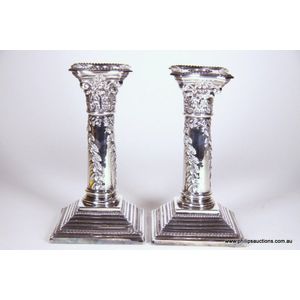Brass-mounted ivory tusk on griffin scroll stand
You must be a subscriber, and be logged in to view price and dealer details.
Subscribe Now to view actual auction price for this item
When you subscribe, you have the option of setting the currency in which to display prices to $Au, $US, $NZ or Stg.
- Griffin / Griffon / Gryphon - A griffin, also known as a griffon or gryphon, is a mythical creature with the body of a lion and the head of an eagle. It is typically depicted as a powerful and majestic beast, with the body and legs of a lion and the head, wings, and talons of an eagle. The griffin is widely recognized as a symbol of strength, courage, and guardianship, and has been used in a variety of cultures throughout history.
In ancient mythology, the griffin was often associated with the gods and was considered a symbol of divine power. In ancient Greece, for example, the griffin was associated with the sun god Helios, while in ancient Egypt, it was associated with the goddess Hathor. In medieval European heraldry, the griffin was used as a symbol of strength, valour, and protection, and was often featured on the coats of arms of noble families. - Ivory - Ivory is a hard white material that comes from the tusks of elephants, mammoth, walrus and boar, or from the teeth of hippopotamus and whales. The ivory from the African elephant is the most prized source of ivory. Although the mammoth is extinct, tusks are still being unearthed in Russia and offered for sale.
Ivory has been used since the earliest times as a material for sculpture of small items, both in Europe and the east, principally China and Japan.
In Asia ivory has been carved for netsuke, seals, okimono, card cases, fan supports, animals and other figures and even as carved tusks.
In the last 200 years in Europe ivory has been used to carve figures, for elaborate tankards, snuff boxes, cane handles, embroidery and sewing accessories, in jewellery and as inlay on furniture. Its more practical uses include being used for billiard balls, buttons, and a veneers on the top of piano keys.
The use and trade of elephant ivory have become controversial because they have contributed to Due to the decline in elephant populations because of the trade in ivory, the Asian elephant was placed on Appendix One of the Convention on International Trade in Endangered Species (CITES), in 1975, and in January 1990, the African elephant was similarly listed. Under Appendix One, international trade in Asian or African elephant ivory between member countries is forbidden. Unlike trade in elephant tusks, trade in mammoth tusks is legal.
Since the invention of plastics, there have been many attempts to create an artificial ivory
This item has been included into following indexes:
Visually similar items

A unusual Russian silver torah pointer, with double headed eagle finial, Russian silver hallmark 84 fineness dated 1889, 20 cm, Wt 80 g

A pair of Sheffield plate column candlesticks, 19th century, the Corinthian style columns with removable shaped nozzles with beaded trims having trailing oak leaves and acorns to the column, raised on stepped and beaded bases; unmarked. Height 16.5 cm

An ornamental representation of a sword,

A late Victorian sterling silver flower vase of tapered cylindrical shape on circular foot with raised floral scroll and leaf decoration. London, 1889. Height 17.5 cm
